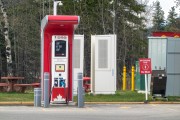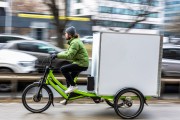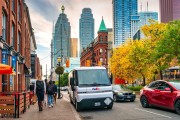For anyone who’s travelled on King Street during rush hour, it’s clear that the current flow isn’t working. Fortunately, cyclists have the option of speedier, safer routes via the Richmond and Adelaide bike lanes, but King Street remains a battleground for cars and transit, and no one is getting anywhere quickly. To try and address this, the City of Toronto is conducting a King Street Visioning Study, as part of the TOCore initiative launched earlier this year. This study is an exciting chance to re-think how we move in and through the downtown. Testing options for improving the King Street corridor through a pilot project is critical to getting people moving.
Since I moved to Toronto four years ago I’ve lived in Roncesvalles and have been dependent on the 504 King Streetcar to get to work in the Financial District and in Parkdale (when I can’t walk or bike). I’ve had to balance my love for the nearly door-to-door service with my frustration with the unreliable wait times, travel times and short turns (which have been improved recently through operational adjustments). As a transportation planner I’m constantly dreaming up solutions that have probably already been proposed and implemented elsewhere – Why can’t we operate a more consistent service? Why isn’t there a dedicated transit lane? Why aren’t peak period rules enforced, which prohibit cars from turning in front of streetcars and slowing everything down?
Residential and business development along King Street has changed so much over the years, and yet the actual design and allocation of space on the street itself hasn’t been touched in the past 100 years. Downtown Toronto is home to over 250,000 residents, and the population is growing. There are around 65,000 weekday transit riders on King Street, compared to 20,000 vehicles. Clearly, something needs to change and we need to prioritize transportation solutions that will serve the most people.
Moving from small strides to big changes
The City of Toronto's Transportation Services has been making operational changes over the past few years, like expanding peak period parking and turn restrictions, researching stop spacing optimization, enforcing penalties for curbside stopping and improving traffic signal prioritization. Buses have also been added to the 504 streetcar route for added capacity, and this summer there will be a new Cherry Street route that will add even more transit capacity to King Street.
While this has lead to some service optimization, the City of Toronto’s 2014 King Street Streetcar study found that 30 to 40 per cent of streetcar delays are related to traffic control signals, and 10 to 20 per cent of delays are related to congestion. These delays could be anything from waiting at intersections, waiting for private vehicles ahead to clear out of the way or turn, as well as waiting for transit vehicles ahead to allow passengers to board[2]. These delays are representative of conflicts between transit and vehicles due to how they share road space and lane configurations. If we want to see major improvements, we need to stop tinkering at the edges and think bigger.
There are huge opportunities to increase transit ridership on King Street in the short term by making streetcar service more convenient and dependable through larger operational improvements and capturing new residents and workers that are quickly moving to neighbourhoods along King Street. Plus, improved service will attract more choice for riders who currently would not consider using the streetcar because of overcrowding or unreliability.
There’s no one-size-fits-all approach to King Street. King Street from Dufferin Street to River Street is 6.1 kilometres long and cuts through the neighbourhoods of Liberty Village, Trinity Niagara, Fashion District, Entertainment District, Financial District, St. Lawrence, and Corktown. Each segment of King Street may require a different transit solution, and now is the time to re-think the role of King Street in our transit network and how it can best serve these diverse neighbourhoods and the 65,000 daily transit commuters.
Stay tuned – over the next few weeks, we will be releasing research looking at options to best move people along King Street, and the benefits of implementing pilot projects to test out planning ideas.







